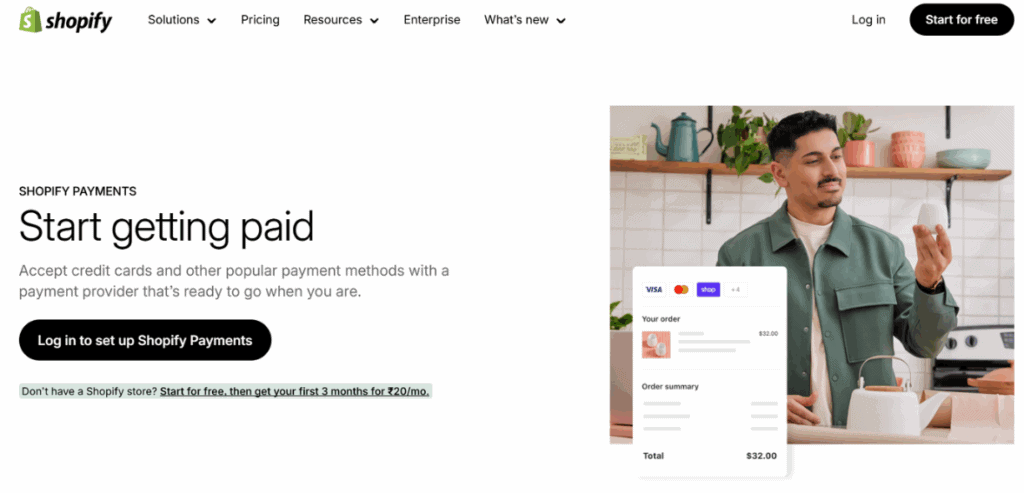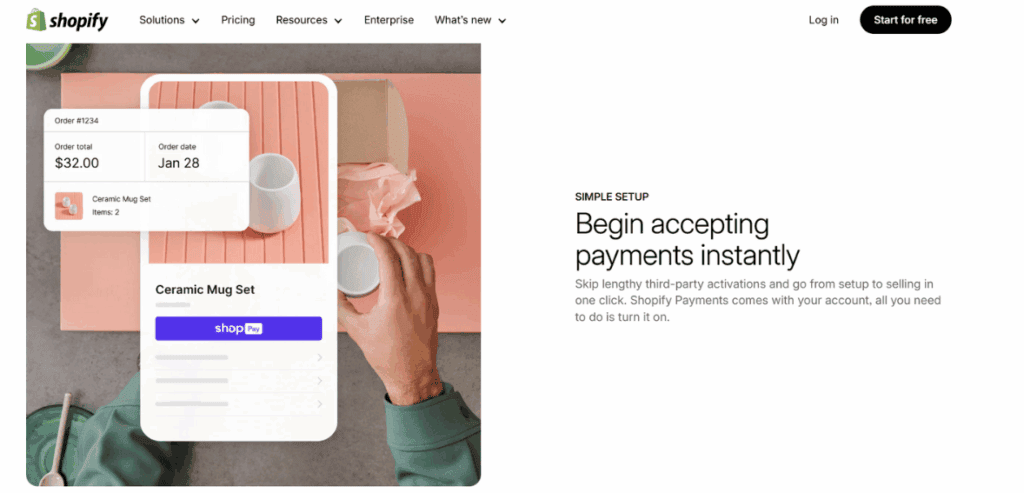
Shopify Payments Review
- 30th Jul, 2025
- | By Linda Mae
- | Reviews
Shopify Payments is Shopify’s own payment gateway, designed to simplify the payment experience for merchants using the platform. Instead of using external processors like PayPal or Stripe, store owners can accept major credit and debit cards directly through Shopify itself. This native solution allows you to manage transactions, track payouts and view payment data all in the same dashboard where you manage products, orders and customers. Lets read more about Shopify Payments Review.
The goal of Shopify Payments is simple: reduce setup time, improve user experience and avoid extra transaction fees with third-party gateways. It also streamlines PCI compliance as Shopify ensures its payment infrastructure meets industry security standards. But while it’s easy to integrate, Shopify Payments has its own rules. It’s not available in all countries and excludes certain business types it deems high-risk. And if you switch from Shopify Payments to a third-party gateway, Shopify will charge an extra transaction fee on top of what your new provider charges.
Shopify Payments is for businesses that want minimal friction and a one-stop solution for ecommerce and payments. But you have to weigh the convenience against the limitations. For eligible businesses in supported regions selling permitted products, it’s an efficient and cost-effective solution. For others, it may be restrictive or not financially viable.
Table of Contents
ToggleKey Features of Shopify Payments | Shopify Payments Review
One of the standout benefits of Shopify Payments is how seamlessly it integrates with the Shopify platform. There’s no need for external signups or account verification from third-party processors; everything is managed directly from the Shopify dashboard. Merchants can start accepting payments as soon as their store is set up and verified.
Shopify Payments supports all major credit and debit cards, including Visa, MasterCard, American Express, and Discover. It also enables payments via digital wallets like Apple Pay and Google Pay, giving customers a flexible and modern checkout experience. Additionally, Shopify supports buy-now-pay-later options such as Shop Pay Installments in eligible regions, which can boost average order value.
Fraud analysis is another built-in feature, helping merchants flag suspicious transactions. While not as advanced as some enterprise-grade fraud tools, it provides an added layer of basic protection without requiring extra integrations.
The platform supports multi-currency functionality, enabling merchants to sell in a shopper’s local currency while receiving payouts on their own. This is particularly useful for international businesses. Moreover, the mobile-optimized checkout experience ensures smooth transactions across devices.
While these features enhance the payment workflow, their true value depends on business size and complexity. For smaller operations or first-time entrepreneurs, the simplicity is unmatched. Larger businesses, however, may find the features somewhat limited compared to specialized gateways. Still, for most Shopify users, these tools are more than sufficient to meet day-to-day ecommerce needs.
Setup and Integration Process
Getting started with Shopify Payments is designed to be hassle-free. For merchants in supported regions, the option to activate Shopify Payments appears right within the admin dashboard. All that’s required is to fill in business details, provide banking information, and complete identity verification. There are no external signups or extra dashboards to manage, which sets it apart from using processors like Authorize.Net or Stripe.
The entire onboarding process typically takes less than 10 minutes, though verification may take a few business days in some cases. Once activated, merchants can immediately begin accepting payments through their online store. There’s no need to handle separate payment gateway APIs or plug-ins, as Shopify Payments is fully embedded in the platform.
For comparison, setting up third-party payment gateways often involves additional integrations, external dashboards, and ongoing syncing between systems. These steps can introduce friction, especially for non-technical users.
One notable aspect is that switching away from Shopify Payments comes with a cost. If a merchant opts for another provider, Shopify charges an additional transaction fee; ranging from 0.5% to 2%; depending on the subscription plan. This financial penalty essentially incentivizes using Shopify Payments by making alternatives more expensive.
Overall, the ease of integration is a major selling point. It’s built for merchants who want to get up and running quickly without navigating the technical complexities of external gateways.

Payment Methods and Supported Currencies
Shopify Payments offers wide-ranging support for popular payment methods. Customers can pay using Visa, MasterCard, American Express, and Discover, along with region-specific options like Bancontact, iDEAL, and Sofort in certain countries. In the U.S., Canada, and other selected markets, support extends to Apple Pay, Google Pay, and Shop Pay, allowing for a fast, mobile-friendly checkout experience.
Beyond card payments, Shopify Payments also supports accelerated checkouts through Shop Pay, which lets customers save their payment and shipping details for future purchases. For merchants looking to reduce cart abandonment, these quick-pay features can be a strong advantage. Another noteworthy benefit is the multi-currency support. Merchants can display prices in local currencies for international customers, while still receiving payouts in their chosen currency. Shopify handles the currency conversion automatically, applying its own conversion rate plus a fee (typically 1.5–2%).
However, some limitations exist. Shopify Payments doesn’t yet support every local payment method globally. For instance, UPI and local wallets may not be available in all regions. Additionally, not all currencies are available for display or settlement, depending on your Shopify plan and location.
In summary, the variety of payment methods and currencies makes Shopify Payments suitable for international commerce. But businesses with highly localized payment needs may still need to supplement it with a third-party solution.
Fees and Pricing Structure
Shopify Payments pricing is transparent but varies based on your Shopify plan and location. Credit card rates are tiered: Basic plan users in the US are 2.9% + 30¢ per transaction, Advanced plan users 2.4% + 30¢. These are comparable to other big processors but can be reduced by upgrading your Shopify plan.
One big benefit of Shopify Payments is that it eliminates the extra transaction fees Shopify charges on stores using external gateways. Without it, Shopify charges 0.5% to 2% per transaction on top of your provider’s processing fees; making third-party gateways more expensive.
Other fees to consider are currency conversion fees which are applied when a customer pays in a different currency than your payout currency. Shopify adds a 1.5% fee on top of the market exchange rate. There may also be extra fees for international card usage depending on the customer’s bank and card type.
Chargebacks are $15 in most regions and while Shopify has some fraud protection tools, they don’t cover these losses unless through Shop Pay’s buyer protection program. Overall Shopify Payments are competitive especially if you’re using the platform exclusively. But international merchants and high volume sellers should calculate the full cost of currency conversions and compare them to other solutions for better financial optimization.
Payouts and Settlement Times
Shopify Payments offers predictable and consistent payout schedules, which is essential for cash flow management. In most countries, payouts are sent to the merchant’s bank account every business day, though it may take 2–4 business days to appear depending on your bank. For new accounts, initial payouts may be delayed slightly while Shopify completes verification checks.
The payout schedule can be customized in some countries, allowing merchants to choose daily, weekly, or monthly disbursements. This flexibility helps businesses better manage working capital and forecast income. All payouts are tracked within the Shopify admin, making it easy to monitor pending and completed transfers, transaction fees, and chargebacks in one place. This centralized system reduces the need for manual reconciliation between payment processors and accounting platforms.
Compared to third-party providers, Shopify’s payout speed is fairly standard. Services like Stripe offer a similar 2-day settlement window, while PayPal often holds funds longer, especially for new accounts or large transactions. However, Shopify Payments does not offer instant payout options at this time, unlike some other platforms that provide same-day deposits for an additional fee.
Bank account setup is straightforward, but it must be a checking account in the store’s legal operating country. International payout routing is not supported, meaning you must have a local bank account in a supported region. In conclusion, Shopify Payments’ payout structure is reliable for most use cases, but instant payout options would be a welcome future addition.
Security, Compliance, and Fraud Prevention
Security is a big deal in payment processing and Shopify has got you covered. It’s PCI DSS compliant so you don’t have to go through your own certification or pay for third party audits. All payment data is encrypted and processed on Shopify’s servers. Shopify also includes basic fraud tools with every transaction. These tools flag suspicious orders based on things like mismatched billing addresses or unusual purchase volumes. Not as advanced as AI driven fraud platforms but a good first layer of defense.
For chargebacks Shopify provides documentation and support but doesn’t reimburse lost revenue or fees unless you’re covered under Shop Pay’s buyer protection program. The $15 chargeback fee applies per incident and is non refundable even if you win the dispute. Tokenization and encryption of card data means customer information isn’t stored in your system so you don’t have to worry about breaches. Shopify Payments also meets 3D Secure requirements where mandated.
As a merchant you also get Shopify’s global infrastructure which is monitored 24/7 for unusual activity and potential threats. However if your business is in a high risk category Shopify may suspend your payouts or even disable your account pending review. Not a full fraud prevention suite but enough for small to mid sized businesses. If you have higher risk exposure you may still need third party fraud tools for deeper controls.

Performance with Subscriptions and Recurring Billing
Shopify Payments has made strides in supporting subscription-based businesses, especially with the introduction of native subscription APIs. Merchants can now offer recurring billing models using apps that integrate directly with Shopify’s backend, reducing reliance on external platforms.
This allows for use cases like monthly product boxes, memberships, or ongoing services; all charged automatically through Shopify Payments. Apps like Recharge, Bold Subscriptions, and others have matured significantly and now offer deep compatibility with Shopify’s checkout and payment infrastructure.
Transactions through Shopify Payments are processed just like standard purchases, with recurring billing tied to customer profiles and payment tokens. This ensures a seamless experience for both customers and merchants.
However, limitations still exist. Not all subscription apps support every Shopify plan, and some require additional monthly fees. Moreover, advanced subscription features like variable billing, mid-cycle changes, or usage-based pricing may require custom development or enterprise-level solutions.
Chargebacks and failed recurring charges are handled similarly to one-time transactions. Merchants need to monitor for failed payments and follow up with customers accordingly. Shopify doesn’t yet offer native dunning management, though third-party apps can fill this gap. In summary, Shopify Payments is more subscription-friendly than ever, but businesses with complex recurring needs may need to evaluate whether its current tools are sufficient.
Limitations and Restrictions
While Shopify Payments brings many advantages, it also comes with some important restrictions. The first is regional availability: Shopify Payments is only supported in select countries such as the U.S., Canada, UK, Australia, and a few others. Merchants outside these areas must rely on third-party gateways.
Another major limitation is the list of prohibited business types. Shopify Payments does not support high-risk industries such as firearms, gambling, adult content, CBD, and some types of financial services. Even within allowed industries, Shopify may freeze payouts or disable the account if it suspects policy violations.
Merchants also report occasional account holds during reviews, especially if sudden spikes in sales or chargebacks occur. During such reviews, payouts can be delayed, which may disrupt cash flow. Additionally, Shopify Payments is only usable within the Shopify ecosystem. If you choose to sell on other platforms or marketplaces, you’ll need to use a separate gateway. This lack of portability can be a downside for multi-channel businesses.
Finally, Shopify Payments has relatively basic reporting tools. While adequate for standard sales tracking, merchants looking for detailed reconciliation or advanced financial analytics may find them limited. These restrictions don’t affect all users, but it’s important to be aware of them before making a full commitment to Shopify Payments as your sole processor.
Who Should Use Shopify Payments?
Shopify Payments is perfect for small to medium sized businesses looking for simplicity, speed and tight integration with the Shopify ecosystem. If your business is in a supported country and not in a restricted industry, it’s often the easiest and most cost effective option. The user-friendly setup, built in fraud tools and seamless checkout experience makes it great for new entrepreneurs, subscription box services and digital product sellers. It also works well for businesses looking to go global with multi currency support.
But it’s not perfect for every use case. Larger businesses with complex payment needs, multi channel sales strategies or high risk product lines may find Shopify Payments too limited or restrictive. The lack of portability, advanced reporting and risk of account freezes are things to consider.
Businesses already using a specialized processor with lower fees or better fraud protection may find it more beneficial to absorb the Shopify transaction fee and stick with their preferred provider. In short, Shopify Payments is convenient and efficient for many but not all merchants. It’s great when used as part of the Shopify ecosystem but not a universal fit for all businesses, growth plans and regions.
FAQs
Q1: Can I use Shopify Payments alongside another payment gateway?
Yes, you can enable other gateways like PayPal or third-party credit card processors alongside Shopify Payments. However, if you disable Shopify Payments, you’ll incur an additional transaction fee per order.
Q2: Are there any hidden fees with Shopify Payments?
There are no hidden fees, but you should be aware of currency conversion charges, international card fees, and chargeback penalties. All applicable fees are listed in Shopify’s pricing terms.
Q3: Is Shopify Payments available in all countries?
No. Shopify Payments is only supported in select countries such as the U.S., UK, Canada, Australia, and a few European and Asian markets. Merchants outside these areas must use external payment gateways.
